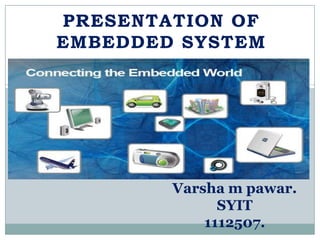
Atm machine
- 1. PRESENTATION OF EMBEDDED SYSTEM Varsha m pawar. SYIT 1112507.
- 2. What is an embedded system An embedded system is combination of some hardware & software either fixed in capability or programming e.g. industrial machine, auto mobile, medical equipment, household appliances, airplanes, toys ,PDA It is dedicated to specific task design. Engineers can optimize if reducing size and cost of the product at the same time increasing the reliability and performance.
- 4. DEFINITION OF ATM MACINE a machine at a bank branch or other location which enables a customer to perform basic banking activities (checking one's balance, withdrawing or transferring funds) even when the bank is closed.
- 5. WHAT IS ATM CARD?? It is a plastic ATM card with a magnetic strip. It contains a unique card number and identity information. It is also known as cash cards, bank card, client card, key card. This card issued by bank.
- 6. HISTORY OF ATM MACHINE Alex robortson has been credited with developing and building the first automatic teller machine in USA The first ATM called Bankograph was installed in Barkleys bank in north London on 27th june 1967 The simultaneous efforts in Japan , Sweden , U.k.been credited in developing the first cash dispenser machine
- 8. MAJOR COMPONENTS OF ATM ATM machine do have various major components which are responsible for the functioning of the Automated teller machine.
- 9. CARD READER: If there will be no card reader, then ATM card can not be read so no transaction can be done by machine. ATM card is required to swipe through this card reader slot. After swiping card it captures the account information through magnetic stripe of ATM. After retrieving the correct information of your account, card reader send this information to the host processor for further process.
- 10. HOST PROCESSOR: Host processor is the heart of ATM machine. It contacts the bank server and retrieves your account details such as available balance, previous transactions, PIN etc It verifies your PIN number and if it matches with the provided PIN number from the bank server, you are allowed to make the transaction. To take your PIN and other requests form user, there will be a keypad or touch pad.
- 11. KEYPAD OR TOUCH PAD: Key pad or touch pad is responsible for taking input from the user. On this pad, numbers and few other keys such as Clear, OK etc., will be placed. Key pad transfers your inputted data to host controller to process the request.
- 12. SPEAKER: Speaker is placed in ATM machine which is responsible for audio alerts. When you press any key, this speaker confirm the pressing of key by producing a beep sound alert. It assures you that the key pad is working. So speaker is also very important part of ATM machine.
- 13. LCD or CRT screen: Another major integral part of the ATM machine is its Cathode Ray Tube (CRT) or Liquid Crystal Diode (LCD) screen. CRT or LCD screen is responsible for visual display of your transactions. It is responsible for displaying your name, entered amount, account number etc. Without CRT or LCD display screen, the transactions from ATM machine would have become more difficult.
- 14. Receipt printer: Receipt printer is responsible for the printing of your transaction's receipt. It will print whether the transaction is successful or not. It contains the important information in the form of fixed codes by which we can assess the transaction status and its reason of failure. SO receipt printer is a vital part of automated teller machine.
- 15. Cash dispenser: The most important part of automated teller machine is its cash dispenser. The cash dispenser is responsible for giving out the correct amount of cash you have requested for. So after getting instruction from host controller to pay the money, cash dispenser will count the money and dispenses the money out of it.
- 16. Making withdrawals. Checking balances and updating Account information. Making deposits. Making funds Transfer. Making payments.
- 17. 1)Customer have access to the cash in bank account whenever he needed. 2)customer can travel anywhere without cash. 3) If customer have ever faced a need of money, then he can probably access on atm machine. 4)For eg., if customer are in stores that does not take checks and credit cards but it has an atm he can withdraw the money for his.
- 18. Not available in remote places. cannot avoid illegal use in case of stolen card.
